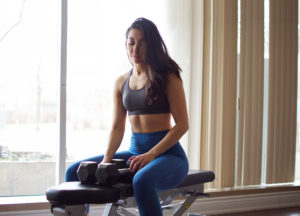The foods we eat before and after workouts can have a definite impact on how our bodies react to exercise. To understand this more, we connected with Nutritionist Maya Eid. As Maya has dealt with her own health challenges through the medicinal power of food, her background was really helpful in approaching this topic. Maya is a Certified Nutritional Practitioner, a health supportive chef and an avid gym rat. Maya loves to blend her background in design with her passion for health by finding creativity in the kitchen, and inspiring others on how to cleverly cook using whole food ingredients and a little imagination.
We chatted with Maya about what we should eat before and after working out, some tips on how to be healthy even while on vacation, and her favourite 10-minute at-home workout.

WEHL: Tell us a little about yourself and why you became interested in holistic wellness.
M.E.: I became a nutritionist because I wanted to learn how to properly nourish my body and restore my health naturally after years of disordered eating, all-nighters and working in a high stress environment. It was a toxic lifestyle where I was taking my health and my body for granted. Eventually the signs and symptoms began to creep up; brain fog, allergies, stomach bloating, lethargy and severe PMS were getting in the way of my day to day.
My determination to find natural solutions to my symptoms led me to discover that my health issues at the time were all stemming from the state of my gut. When you’re not placing importance on your overall well-being, your gut takes the first hit – that’s the root of where all diseases and conditions begin. Since then I’ve made it my mission to focus on digestive health and to practice being more kind to myself and my body.
WEHL: What is your philosophy on wellness?
M.E.: My philosophy is centred around achieving optimal health in a way that is sustainable and enjoyable long term, free from restriction or deprivation. It’s not just about fitness and nutrition, it’s about awareness and tuning into our inner wisdom that is in touch with our feelings, desires, beliefs and sense of purpose. It’s about training the mind to acknowledge only positive attitudes, beliefs and thoughts.

WEHL: Why did you decide to become a holistic nutritionist with a focus on fitness?
M.E.: After learning more about how nutrition and fitness go hand in hand in order to achieve specific health goals, I realized that exercise is way more than a weight loss tool that society has led us to believe. I have come to focus on fitness because I see how valuable it is to influence so many positive outcomes such as balanced hormones, improved digestion, improved sleep quality, a happier mood, a strong heart and strong bones. I wanted my clients to understand the power that the two have when they work together in harmony, instead of a “calories in, calories out” approach. It’s much more intricate than that.
WEHL: What should we be eating before a workout and why? Do you have any recipes you’d like to share?
M.E.: Pre-workout nutrition is important because it improves your ability to train a little harder and a little longer, effectively increasing the volume of your training. You should eat your pre-workout meal or snack 60-90 minutes before exercise and it should focus on a carbohydrate source because it will transform into fuel for your workout. Depending on your day and hunger levels, it could be a balanced meal containing something like sweet potatoes, seasoned chicken and a little olive oil, or if you just need a snack I usually advise a piece of fruit since it contains natural sugars that are a great source of energy.
It’s important to consume protein and carbohydrates. When you exercise, you are effectively tearing and breaking muscle fibres apart, which then need to be repaired by the body through protein intake. Carbohydrates are necessary during the post-workout period in order to replace muscle glycogen (the storage form of carbohydrates) and improve recovery. Smoothies offer a faster method of delivering protein and carbohydrates to the muscle, which betters your chances for muscle building and recovery. Here’s a delicious post workout smoothie recipe I designed that helps to support digestion, as well as accelerate muscle recovery and gain.

WEHL: If we’re working out in the morning, should we eat before? If so, what should we eat?
M.E.: It depends on the individual; there are some that can roll right out of bed and into an exercise class no problem, and then others that will feel weak and nauseous without a bite of something beforehand. Those that need to eat, stick to something easy to digest like a piece of fruit or a small serving of cooked oatmeal and cinnamon. Those that do well with fasted workouts my recommendation is to always eat a well balanced meal the night before, with emphasis on the carbohydrate portion as that glucose will be waiting for you to put it into use once you wake up.
WEHL: Is it normal to have muscle soreness the day after working out? How can we reduce this?
M.E.: It’s totally normal! Note that it can take about 2 weeks for your body to get adjusted to a new workout regime, so those first couple weeks may involve slower recovery than usual, but you can consider this as normal. Beyond that, recovery really shouldn’t take longer than 48 hours. In order to help reduce muscle soreness ensure that you’re getting adequate protein. I always mention roughly 0.8g of protein per pound of lean body weight (i.e. 112 grams of protein for a 140 lbs person).
WEHL: Do you have a quick 10-15 minute at home workout that anyone could fit into their day?
M.E.: Here’s one I love because it incorporates full body endurance and core conditioning using just your body weight. Your core is the lower back, hips, glutes, trunk, and stomach. Many people who sit at their desk all day tend to have a weak core as a result, which can lead to back problems and injuries.
Here’s the sequence:
- Walkouts – 1 minute
- Alternating Reverse Lunge Reaches – 10 repetition
- Alternating Split Jumps – 30 seconds (beginner: alternating lunges)
- Plank Walks – 30 seconds (beginner: plank hold)
- Bodyweight Jump Squats – 30 repetitions (beginner: bodyweight squats)
- Left Side Plank Leg Lifts – 30 seconds (beginner: left side plank)
- Right Side Plank Leg Lifts – 30 seconds (beginner: right side plank)
- Swimmers – 30 seconds
- Repeat X2

WEHL: What are some of your tips for eating healthy and exercising when you’re on vacation?
M.E.: What works for me is ensuring I’m eating at least a serving of vegetables alongside anything I want to try on the menu. I love trying out each destination’s delicacies and staples, but I choose one thing a day; I don’t make it a whole day excursion of eating whatever I want because that usually results in an upset stomach and low energy and those are the last two things I want to experience while I’m away relaxing and exploring! Whenever I’m on vacation, my itinerary usually involves a ton of walking or fun outdoor activities like cycling, hiking and swimming. If I’m visiting a city I usually sign up for fitness classes that are different than my regular workouts back home. I recommend switching up your exercises time to time to challenge your body and keep you motivated.
WEHL: When we get home from a long day, how can we motivate ourselves to exercise?
M.E.: Oh yes, I’ve been there many times, talking myself into exercising after a long day. It’s common that we come home tired and very hungry. I’ve learned that the best way is to set yourself up by bringing snacks to eat just before your work day ends to offset hunger for a little while; that way you’ll have just enough energy to shoot over to the gym right after work. Make sure to either bring your gym clothes with you to work or if you have to come home first then have your gym clothes already set out so you quickly change into them without thinking twice.
Connect with Maya Eid:
- Web: www.mayaeid.com
- Email: [email protected]
We invite you to join our all-in-one healthy lifestyle app at Wehl.com!



